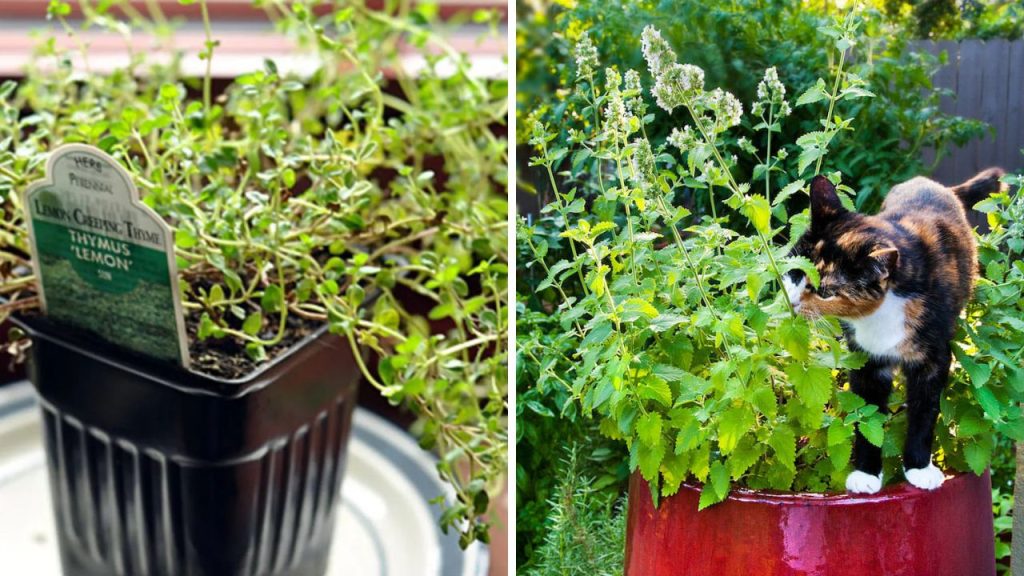Creating your own raised garden beds is a fun and rewarding way to grow your favorite plants and vegetables! With 19 unique DIY designs to choose from, you’ll find the perfect match for your yard or patio. Building these beds can boost your gardening game, enhance soil drainage, and make tending to your plants a breeze. Let’s jump right in and explore how you can make the most of your gardening space!
Using Recycled Materials for Sustainable Gardening

Creating raised garden beds from recycled materials is a fantastic way to promote sustainability. The image shows a simple yet effective raised bed made from wooden pallets. These pallets are often discarded, making them an eco-friendly choice for gardening.
Using pallets not only saves money but also reduces waste. The bed is filled with rich soil, ready for planting. You can see young plants starting to grow, which adds a touch of life to the setup. This method is perfect for those who want to start gardening without investing heavily in new materials.
Building with recycled materials encourages creativity. You can customize your garden beds to fit your space and style. Plus, it’s a fun project for families or friends to tackle together. So, gather some pallets and get started on your sustainable gardening journey!
Selecting Materials for Your DIY Raised Garden Bed
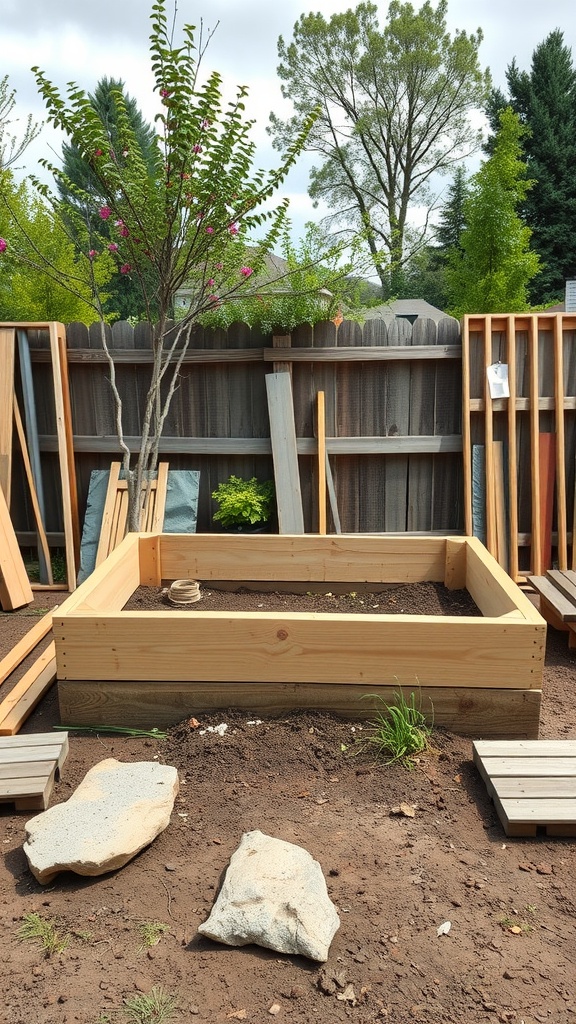
Building a raised garden bed can be a fun project, and choosing the right materials is key to its success. In the image, you can see a sturdy wooden frame taking shape, surrounded by various materials. This setup gives a clear idea of what you might need.
When selecting wood, opt for untreated varieties like cedar or redwood. These types resist rot and pests, making them ideal for your garden. The image shows a clean, rectangular frame that will hold soil and plants securely.
Don’t forget about the base! Using landscape fabric at the bottom can help with drainage while keeping weeds at bay. You can see some stones nearby, which can also be used to create pathways around your garden bed.
Lastly, think about the height of your bed. A depth of 12 to 24 inches is usually perfect for most vegetables. The raised bed in the picture looks inviting and ready for planting, showing how easy it can be to get started on your gardening journey.
Adding a Liner to Your Raised Garden Bed
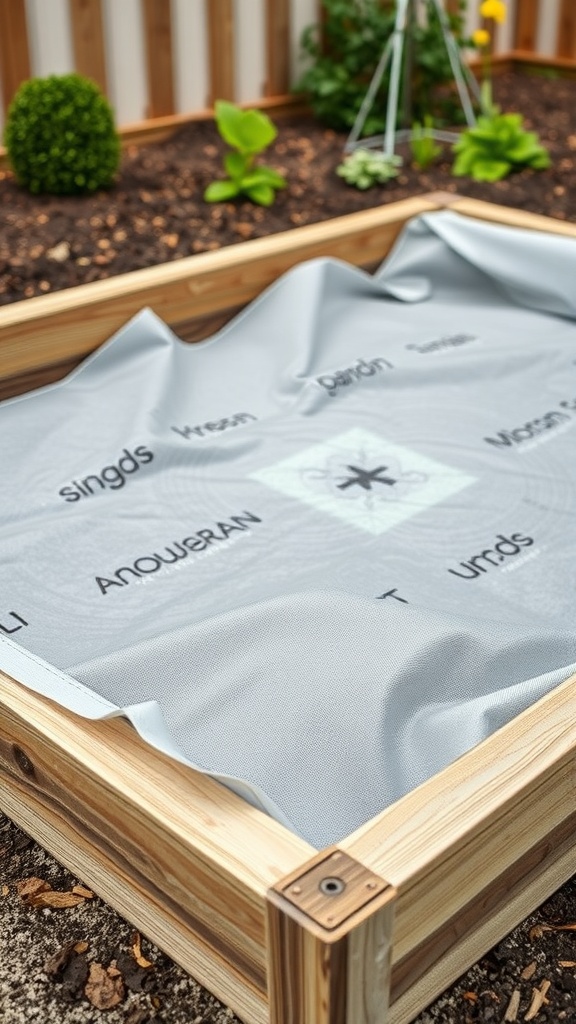
Using a liner in your raised garden bed is a smart move. It helps keep the soil in place and prevents weeds from creeping in. In the image, you can see a neatly placed liner inside a wooden frame, ready for planting. This setup not only looks tidy but also protects the wood from moisture damage.
When choosing a liner, go for materials that allow water to drain while keeping soil intact. A landscape fabric or a heavy-duty plastic can work well. Make sure to cut the liner to fit snugly, covering the bottom and sides of the bed.
Once your liner is in place, you can fill the bed with quality soil. This step is crucial for healthy plant growth. With the liner acting as a barrier, your plants will thrive without the worry of weeds or soil loss.
Building a Simple Wooden Raised Garden Bed
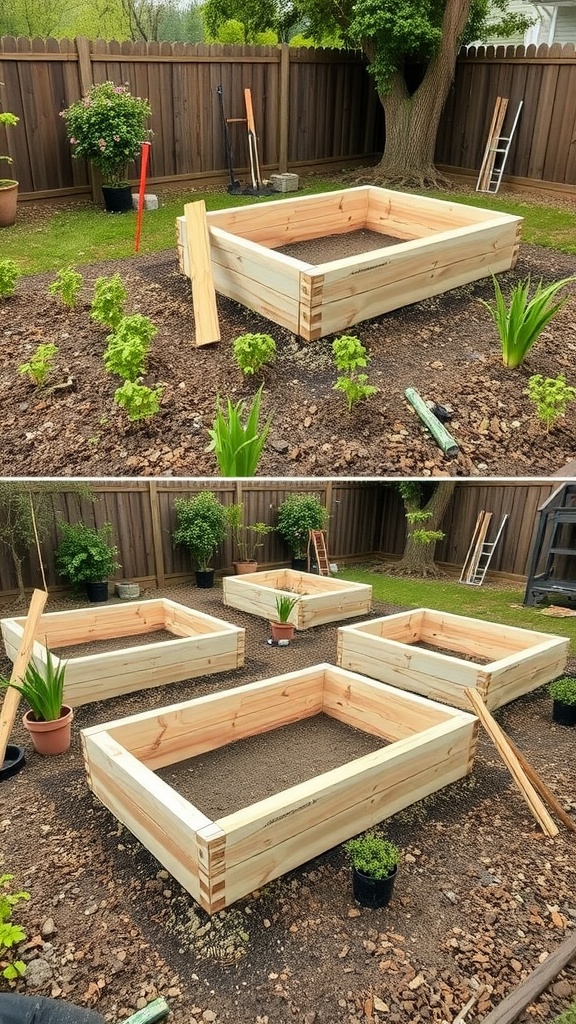
Creating a wooden raised garden bed is a fun and rewarding project. The image shows several neatly constructed beds, ready for planting. These beds are made from sturdy wood, providing a great environment for your plants.
In the picture, you can see one bed partially completed, with fresh soil inside. The other beds are lined up, waiting to be filled. This setup is perfect for growing vegetables or flowers, giving your garden a tidy look.
Using raised beds helps with drainage and keeps pests away from your plants. Plus, they can be built to any size that fits your space. Grab some wood, nails, and a few tools, and you’re on your way to a beautiful garden!
Choosing the Right Location for Your Raised Garden Bed
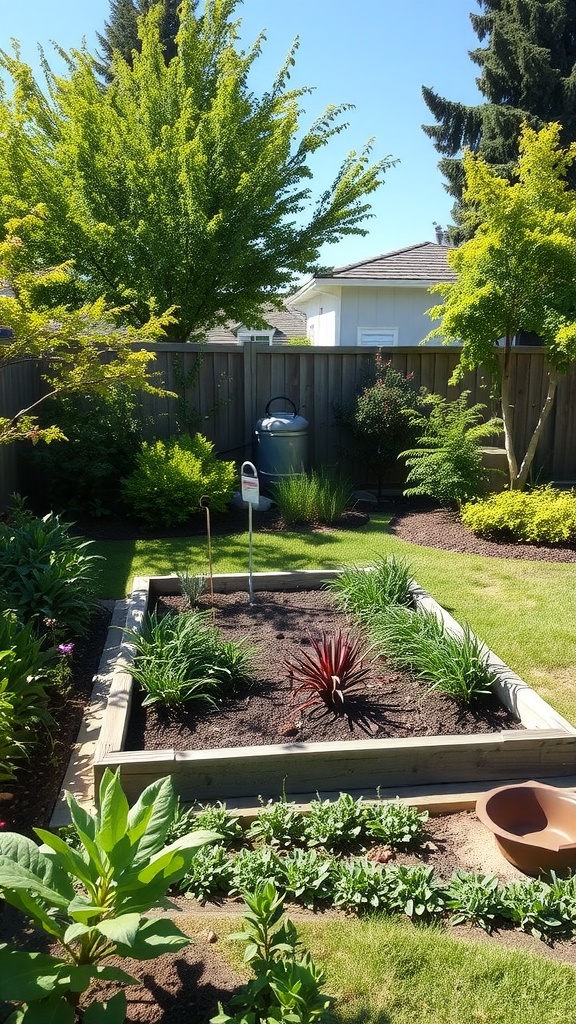
Finding the perfect spot for your raised garden bed is key to a successful garden. Look for a place that gets plenty of sunlight, ideally six to eight hours a day. This helps your plants grow strong and healthy.
The image shows a well-placed raised garden bed surrounded by lush greenery. Notice how the bed is situated in a sunny area, making it an ideal choice for growing various plants. The surrounding plants and trees add beauty and can provide some shade during the hottest parts of the day.
Also, consider accessibility. You want to be able to reach your garden easily for watering, weeding, and harvesting. A location close to your home can make this task simpler and more enjoyable.
Lastly, think about drainage. Raised beds should be placed where water can drain away easily. Avoid low spots where water might collect. This will help prevent root rot and keep your plants thriving.
Determining the Ideal Size for Your Garden Bed
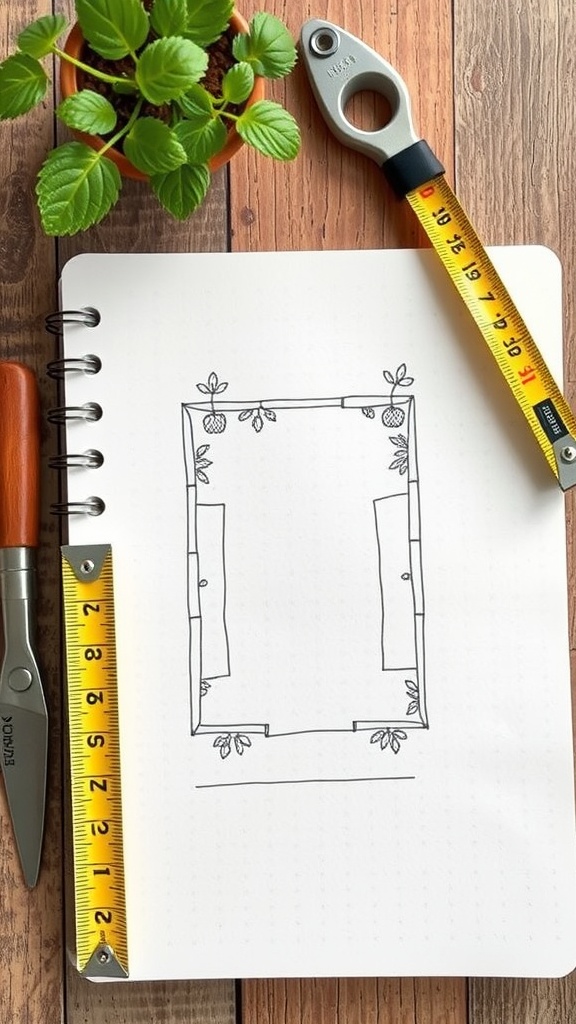
When planning your raised garden beds, size matters. The image shows a sketch of a garden bed layout, complete with measuring tools. This visual can help you visualize your space and plan accordingly.
Start by thinking about what you want to grow. Different plants have different space needs. For example, leafy greens can be planted closer together than larger vegetables like tomatoes. A common size for a raised bed is 4 feet by 8 feet, but you can adjust based on your garden’s layout.
Consider how much space you have available. Make sure you can easily reach the center of the bed for planting and maintenance. A width of 4 feet allows you to access all parts without stepping into the bed, which is key for healthy soil.
Don’t forget about height! Raised beds can be anywhere from 6 to 24 inches tall. Taller beds are easier on the back but may require more soil. Think about your comfort and the types of plants you want to grow.
Incorporating a Trellis into Your Raised Bed
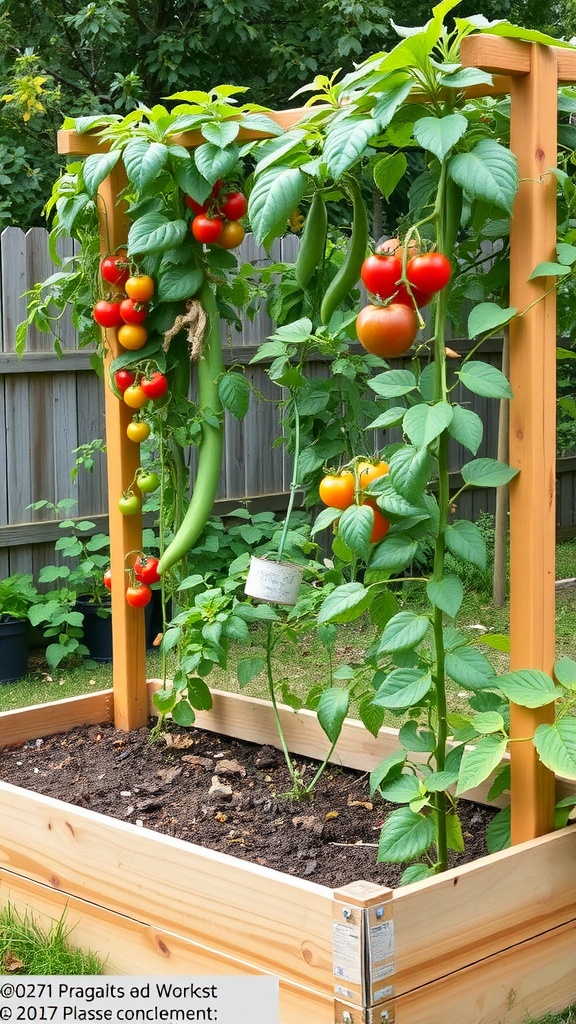
Adding a trellis to your raised garden bed is a smart way to maximize space and support your plants. In the image, you can see a sturdy wooden trellis that supports healthy tomato plants. The vibrant red and yellow tomatoes hang down, showcasing the benefits of vertical gardening.
A trellis not only helps plants grow upward, but it also improves air circulation and sunlight exposure. This can lead to healthier plants and a more bountiful harvest. Plus, it makes harvesting easier!
When building your trellis, consider the materials you use. Wood is a popular choice for its durability and natural look. You can easily attach it to your raised bed, creating a seamless design. Make sure it’s tall enough to support your plants as they grow.
Incorporating a trellis can also add visual interest to your garden. The sight of climbing plants can create a beautiful focal point. So, whether you’re growing tomatoes, cucumbers, or beans, a trellis is a great addition to your raised bed garden.
Creating a Tiered Raised Garden Bed Design
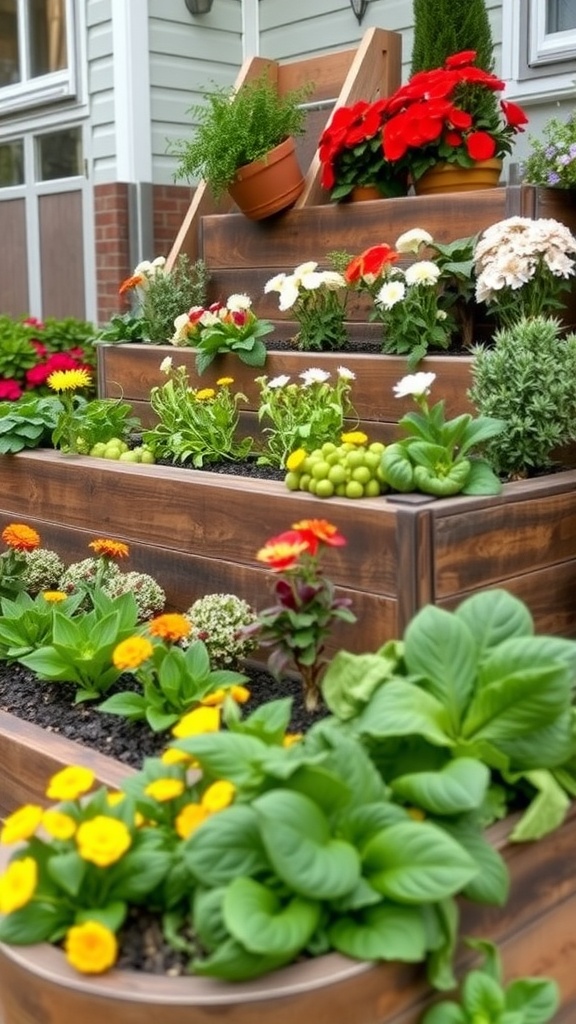
Tiered raised garden beds are a fantastic way to maximize space and add visual interest to your garden. The image shows a beautiful example of this design, featuring multiple levels filled with vibrant flowers and lush greens. Each tier allows for different plants, making it easy to grow a variety of herbs, vegetables, and flowers.
The wooden structure not only looks great but also provides excellent drainage and soil depth for the plants. You can see how the steps lead up to the higher tiers, making it easy to access all areas of the garden. This design is perfect for smaller yards where space is limited.
Incorporating a tiered design can also help with sunlight exposure. Higher plants can thrive without shading the lower ones. Plus, it adds a unique touch to your outdoor space, making it a lovely spot for relaxation or entertaining.
Soil Preparation for Optimal Plant Growth
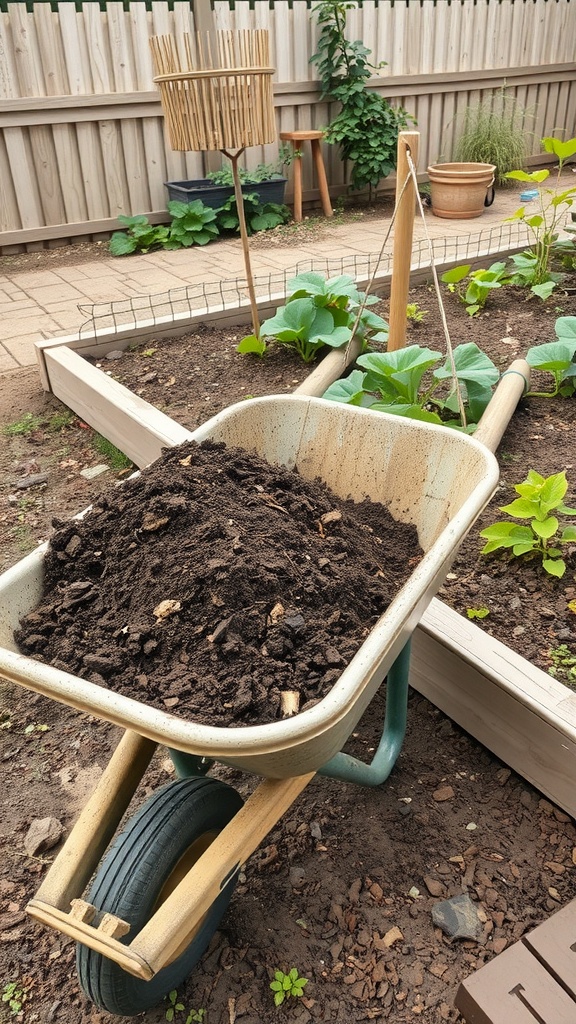
In the image, we see a wheelbarrow filled with rich, dark soil, ready to be used in raised garden beds. This soil is essential for growing healthy plants. The raised beds in the background show young plants thriving, indicating that proper soil preparation is already in progress.
Good soil is the foundation of any successful garden. Start by mixing in organic matter like compost. This not only improves soil structure but also provides vital nutrients. The wheelbarrow is a handy tool for transporting soil and amendments to your garden beds.
Make sure to check the soil’s pH level. Most plants prefer a slightly acidic to neutral pH. If your soil is too acidic or alkaline, you can adjust it with lime or sulfur. This simple step can make a big difference in plant health.
Don’t forget to aerate the soil. This helps with drainage and allows roots to breathe. You can use a garden fork or a tiller for this task. With the right soil preparation, your plants will have the best chance to grow strong and vibrant.
Watering Solutions for Raised Garden Beds

Keeping your raised garden beds hydrated is key to growing healthy plants. The image shows a simple irrigation system set up in a garden. This setup is practical and efficient, making it easier to water your plants without much hassle.
Using a drip irrigation system, like the one in the photo, ensures that water goes directly to the roots. This method saves water and keeps the soil moist without overwatering. You can easily install a system with tubing and connectors, which are available at most garden centers.
Another option is to use soaker hoses. These hoses slowly release water along their length, providing consistent moisture to your plants. Just lay them out in your garden beds and connect them to a water source.
For those who prefer a more hands-on approach, a watering can or a hose with a spray nozzle works too. Just be mindful of how much water you’re giving each plant. Consistency is key!
Harvesting and Enjoying Your Homegrown Produce

Harvesting your own vegetables is one of the most rewarding parts of gardening. Picture yourself in a vibrant garden, surrounded by lush plants. In this image, a joyful gardener is picking fresh greens and tomatoes, showcasing the fruits of their labor.
Raised garden beds make it easy to grow a variety of produce. They provide better drainage and soil quality, which leads to healthier plants. You can see a mix of leafy greens, tomatoes, and other vegetables thriving in the bed. This setup not only looks great but also makes harvesting simple and enjoyable.
Once you’ve gathered your produce, the fun continues in the kitchen. Fresh vegetables can be used in countless recipes. Toss them in a salad, sauté them for a side dish, or blend them into a smoothie. The possibilities are endless!
Sharing your harvest with friends and family can also enhance the experience. Imagine hosting a dinner where everything on the table comes from your garden. It’s a great way to celebrate your hard work and enjoy the fruits of your labor.
Creating Decorative Edging for Your Garden Bed
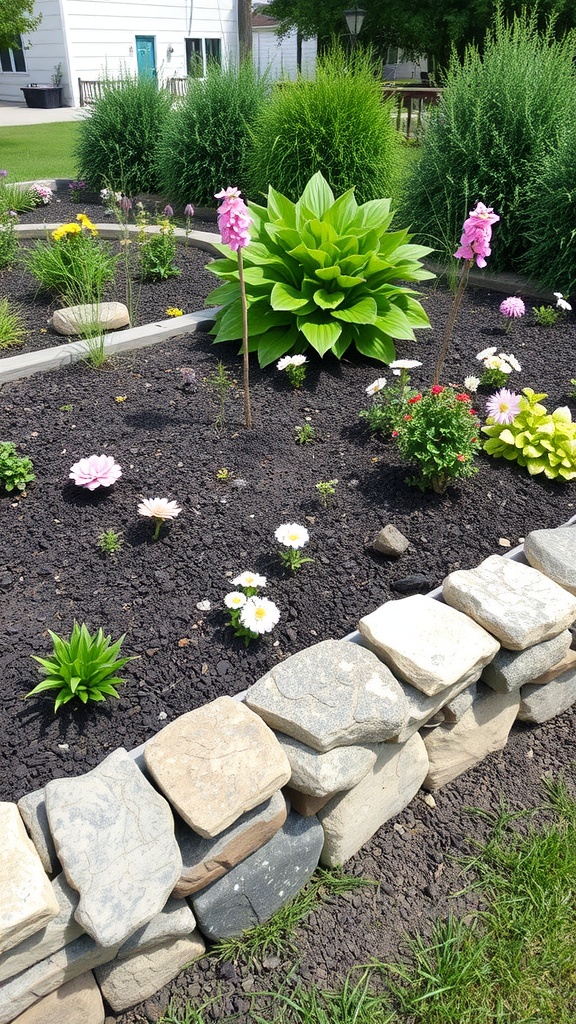
Decorative edging can really make your garden bed pop. In the image, you can see a lovely arrangement of stones forming a neat border around the flower bed. This not only keeps the soil in place but also adds a touch of charm to the overall look.
Using stones for edging is a fantastic DIY option. It’s durable and blends well with the natural surroundings. You can choose stones of different shapes and sizes to create a unique design that reflects your personal style.
Incorporating plants like daisies and hostas, as shown in the image, adds color and life to the garden. The vibrant flowers contrast beautifully with the dark soil and the stone edging, creating a welcoming atmosphere.
When planning your garden bed, think about how the edging will complement the plants. A well-defined border can enhance the beauty of your flowers and make maintenance easier. Plus, it gives your garden a polished look that you’ll love showing off.
Designing a Companion Planting Layout
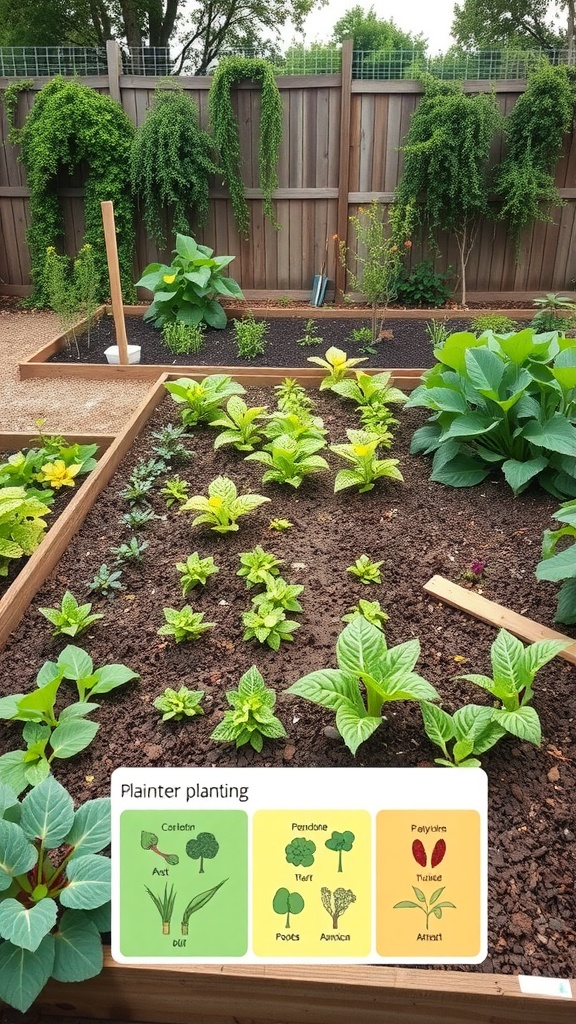
Companion planting is a fun way to maximize your garden’s potential. The image shows a vibrant raised garden bed filled with various plants. Each plant has its own role, helping others grow better. For example, leafy greens like lettuce can thrive alongside herbs that deter pests.
In this layout, you can see different plants arranged thoughtfully. The companion planting chart at the bottom highlights which plants work well together. This visual guide makes it easy to plan your garden. It’s like having a buddy system for your plants!
When designing your layout, think about the height and spread of each plant. Taller plants can provide shade for shorter ones. This helps create a balanced environment. Plus, it’s visually appealing! Mixing colors and textures adds beauty to your garden.
Don’t forget to consider the soil needs of each plant. Some prefer rich soil, while others thrive in sandy conditions. Adjust your soil mix accordingly to keep everyone happy. With a little planning, your garden can be a thriving ecosystem.
Choosing the Right Plants for Your Raised Bed
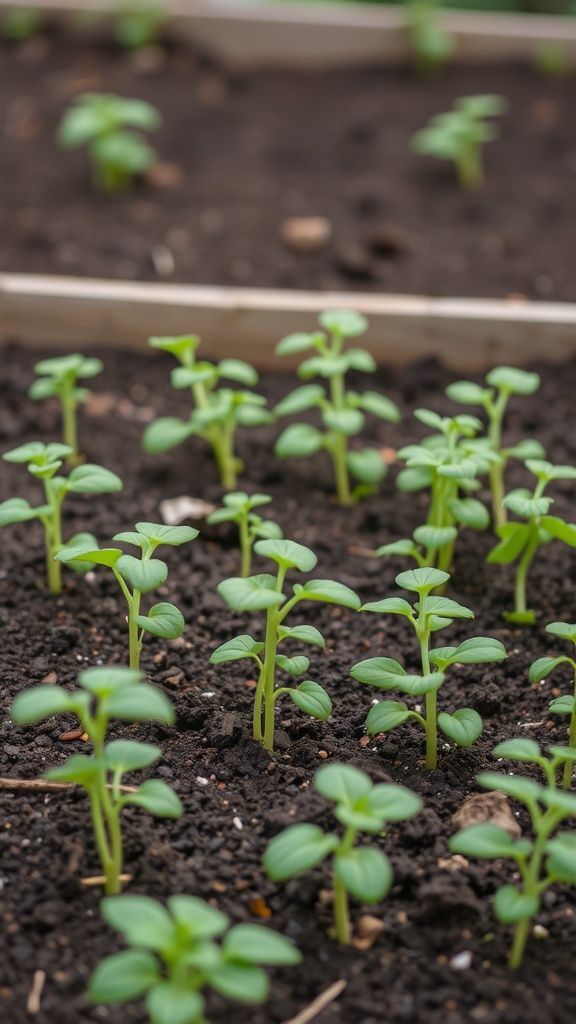
When setting up your raised garden beds, picking the right plants is key. The image shows vibrant young seedlings sprouting in rich, dark soil. These little plants are full of potential and ready to grow into something wonderful.
Start by thinking about what you enjoy eating. If you love fresh tomatoes, peppers, or herbs, those are great choices for your raised beds. They thrive in the warm, nutrient-rich environment that raised beds provide.
Consider the space you have. Some plants, like zucchini, need more room to spread out, while others, like radishes, can be planted closer together. Mixing taller plants with shorter ones can also maximize your space and create a beautiful garden.
Don’t forget about companion planting! Some plants grow better together. For instance, basil loves being near tomatoes. This not only helps the plants thrive but can also enhance their flavors.
Lastly, think about your climate. Some plants prefer cooler weather, while others love the heat. Check your local gardening zone to find the best options for your area. With the right choices, your raised beds will flourish!
Maintaining Your Raised Garden Bed Throughout the Seasons
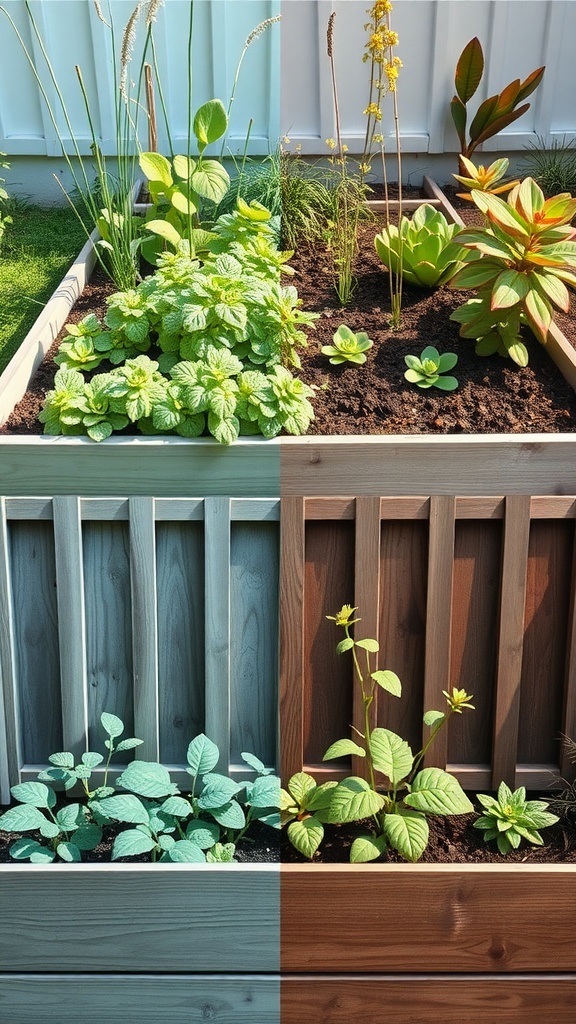
Raised garden beds are a fantastic way to grow your plants while keeping them organized and easy to manage. The image shows a vibrant selection of plants thriving in different sections of a raised bed. You can see lush greens, colorful succulents, and even some herbs, all showcasing the beauty of a well-maintained garden.
To keep your raised garden bed flourishing, regular maintenance is key. Start by checking the soil moisture. Plants in raised beds can dry out faster, so make sure to water them consistently, especially during hot months. A good rule of thumb is to water deeply but less frequently.
Next, keep an eye on weeds. They can compete with your plants for nutrients and water. Pull them out regularly to give your plants the best chance to thrive. Mulching can also help suppress weeds and retain soil moisture.
As seasons change, consider rotating your crops. This helps prevent soil depletion and keeps pests at bay. Different plants have varying nutrient needs, so rotating can lead to healthier soil.
Finally, don’t forget about fertilizing. Using organic compost or a balanced fertilizer can give your plants the nutrients they need to grow strong. With a little care, your raised garden bed can be a beautiful and productive space all year round!
